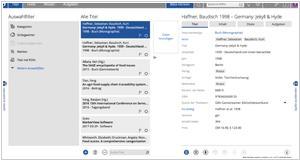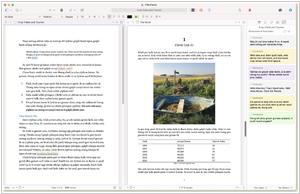Citavi vs Scrivener
Last updated: October 21, 2023
Citavi and Scrivener are two software applications designed for different aspects of the writing and research process, and they have key differences in terms of their features, focus, and functionality. Firstly, Citavi is primarily a reference management and research organization tool. It helps researchers and academic writers collect, organize, and cite sources for their projects. Citavi offers features such as database integration, advanced search capabilities, and citation management. It allows users to store and annotate sources, create bibliographies, and track references efficiently. Citavi also provides tools for note-taking and outlining, making it a comprehensive solution for managing research materials. However, Citavi does not have the same focus on creative writing and project organization as Scrivener.
On the other hand, Scrivener is a writing software application that focuses on the creative writing and project management aspects. It offers a range of tools for writers to plan, draft, and organize their written works. Scrivener provides a flexible and customizable interface that allows writers to break their projects into sections, rearrange content, and view their work in various ways. It offers features like outlining, note-taking, and the ability to set writing goals and targets. Scrivener also supports multiple file formats and allows users to export their work into various formats suitable for publishing or sharing. While Scrivener has some research-related features, its primary focus is on the writing process rather than research management like Citavi.
Another key difference between Citavi and Scrivener lies in their target users and compatibility. Citavi is widely used by researchers, academics, and students who need a tool to manage and organize their research materials and citations. It is compatible with Windows operating systems, making it accessible to a broad user base. On the other hand, Scrivener caters to a wider range of writers, including novelists, screenwriters, and non-fiction authors. It is available for Windows, macOS, and iOS platforms, allowing users to seamlessly work on their projects across different devices. This cross-platform compatibility makes Scrivener a versatile choice for writers who use various devices in their writing process.
On the other hand, Scrivener is a writing software application that focuses on the creative writing and project management aspects. It offers a range of tools for writers to plan, draft, and organize their written works. Scrivener provides a flexible and customizable interface that allows writers to break their projects into sections, rearrange content, and view their work in various ways. It offers features like outlining, note-taking, and the ability to set writing goals and targets. Scrivener also supports multiple file formats and allows users to export their work into various formats suitable for publishing or sharing. While Scrivener has some research-related features, its primary focus is on the writing process rather than research management like Citavi.
Another key difference between Citavi and Scrivener lies in their target users and compatibility. Citavi is widely used by researchers, academics, and students who need a tool to manage and organize their research materials and citations. It is compatible with Windows operating systems, making it accessible to a broad user base. On the other hand, Scrivener caters to a wider range of writers, including novelists, screenwriters, and non-fiction authors. It is available for Windows, macOS, and iOS platforms, allowing users to seamlessly work on their projects across different devices. This cross-platform compatibility makes Scrivener a versatile choice for writers who use various devices in their writing process.
10
Citavi is the only reference management program for teams that gives you the option of storing your information on your own server instead of in the cloud.
64
Scrivener is the go-to app for writers of all kinds, used every day by best-selling novelists, screenwriters, non-fiction writers, students, academics, lawyers, journalists, translators and more. Scrivener won't tell you how to write—it simply provides everything you need to start writing and keep writing.
Citavi vs Scrivener in our news:
2022. Citavi inlines Web version with desktop's
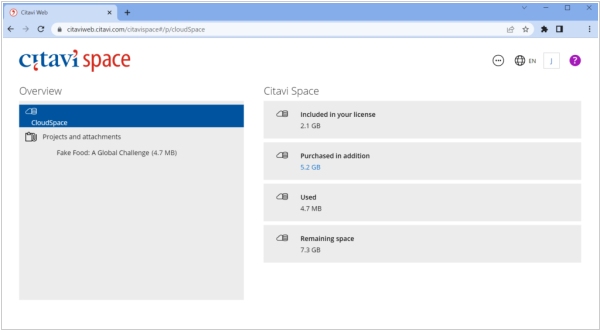
Citation Management software Citavi has released a new version that brings the writing and knowledge management features of Citavi Web in line with Citavi for Windows, providing Mac users access to these capabilities. The Word Assistant now enables users to insert category systems, which was previously only available through the Citavi for Windows Word Add-In, making it inaccessible to Mac and Citavi Web-only users. Additionally, users can insert categorized knowledge items along with their outline, allowing them to obtain a bird's-eye view of their project and identify gaps where more research is necessary. The update also enhances the handling of knowledge items in the Citavi Assistant to achieve feature parity with the Citavi Word Add-In for Windows.
2021. Scrivener 3 for Windows gets simple and beautiful interface
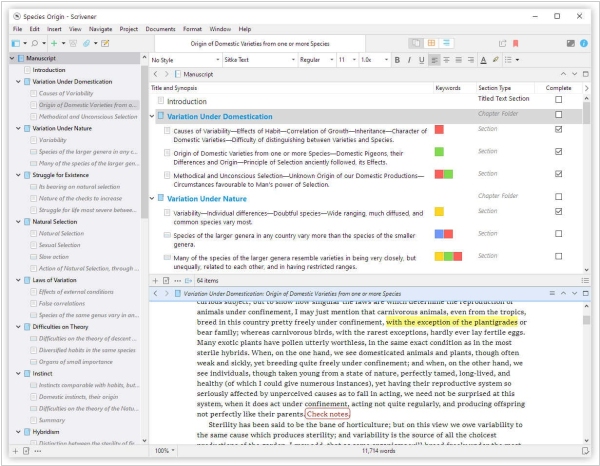
The latest version of Scrivener 3 is now available on Windows, bringing with it a variety of new and improved features. The update includes a modernized and simplified interface, a redesigned and more flexible Compile feature, and a full styles system in the text system. Other enhancements include the ability to view index cards on colored threads, improved ebook export, and the addition of Writing History to track daily writing progress. Custom Metadata has also been improved, allowing for checkboxes, dates, and list boxes to be added to the Inspector and outliner. Additional features include enhanced outlining, a new Quick Search tool, progress bars, and a Dark Mode, among others. The Bookmarks feature also replaces Project Notes, References, and Favorites, making it easier to access frequently used documents. Furthermore, the Dialogue Focus feature allows users to easily locate all dialogue within their text.
2019. Scrivener for iOS adds support for many more screen types
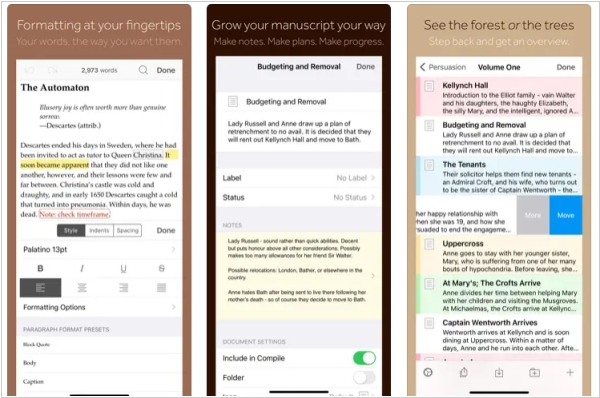
The latest version of Scrivener for iOS, version 1.2, is now available to download from the App Store and offers support for iOS 13, improved compatibility with a wider range of screen types, and seamless integration with iOS 13's dark mode. Alongside these enhancements, existing features of the app include the ability to write and organize your manuscript in sections of any size, view all sections as a single text, navigate sections quickly using the binder sidebar, format with fonts and presets, and use comments, footnotes, links, highlights, simple bullets, and lists. Additionally, the app allows you to insert images, resize text with pinch-zoom, use full-screen and typewriter scrolling modes (iPad only), write a screenplay using scriptwriting mode, check live word and character counts, set targets for word and character counts, find and replace text, and customize the keyboard row and shortcuts for external keyboard users.
2018. Scrivener for macOS adds Dark mode and Scriptwriting

Scrivener 3.1 is a major update for macOS that introduces a number of new features and enhancements. One notable addition is full support for dark mode on macOS 10.14, which allows you to take full control over colors and UI in each mode. Scrivener 3.1 also offers scriptwriting improvements, such as support for "MORE" and "CONT'D" when compiling for PDF and printing, dual dialogue support, and an option to not split sentences across pages in scripts. Enhancements to Compile include the ability to include a cover image when compiling to PDF, improved options for compiling for print-on-demand services, and direct formatting for Epub 3 and Kindle KF8 formats. Additionally, a new "focus mode" is available to fade out everything except the current line, sentence, or paragraph as you write.
2017. Scrivener 3 for macOS gets Compile feature
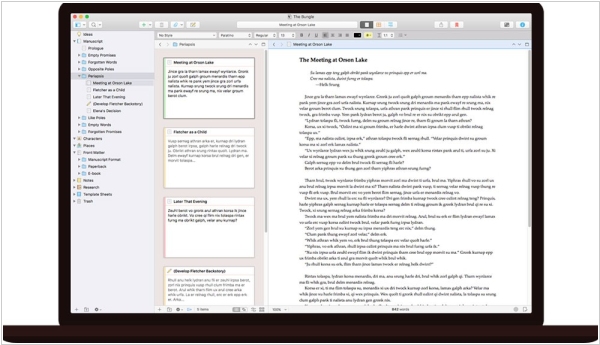
Scrivener 3 is now available for macOS starting at $59.99. Scrivener 3 is a significant update that not only introduces new and exciting features but also enhances and simplifies the existing ones. The update includes several notable improvements such as a modernized interface, a more flexible and easier-to-use Compile feature, and a full styles system in the text system that is more powerful with the new Compile. Additionally, users can view index cards on colored threads to track different storylines and filter Corkboard and outliner. Other enhancements include improved metadata, the ability to track daily writing progress with Writing History, and the new Quick Search tool to find any document quickly. The Bookmarks feature replaces Project Notes, References, and Favorites, allowing users to access frequently used documents easily. Furthermore, users can now use "Dialogue Focus" to locate all dialogue within their text and export rich text to MultiMarkdown or Pandoc. Scrivener 3 also broadens support for technical formats via Markdown output and custom post-processing. The macOS version has extensive Touch Bar support and a rewritten 64-bit codebase that makes Scrivener faster, more stable, and future-ready.

